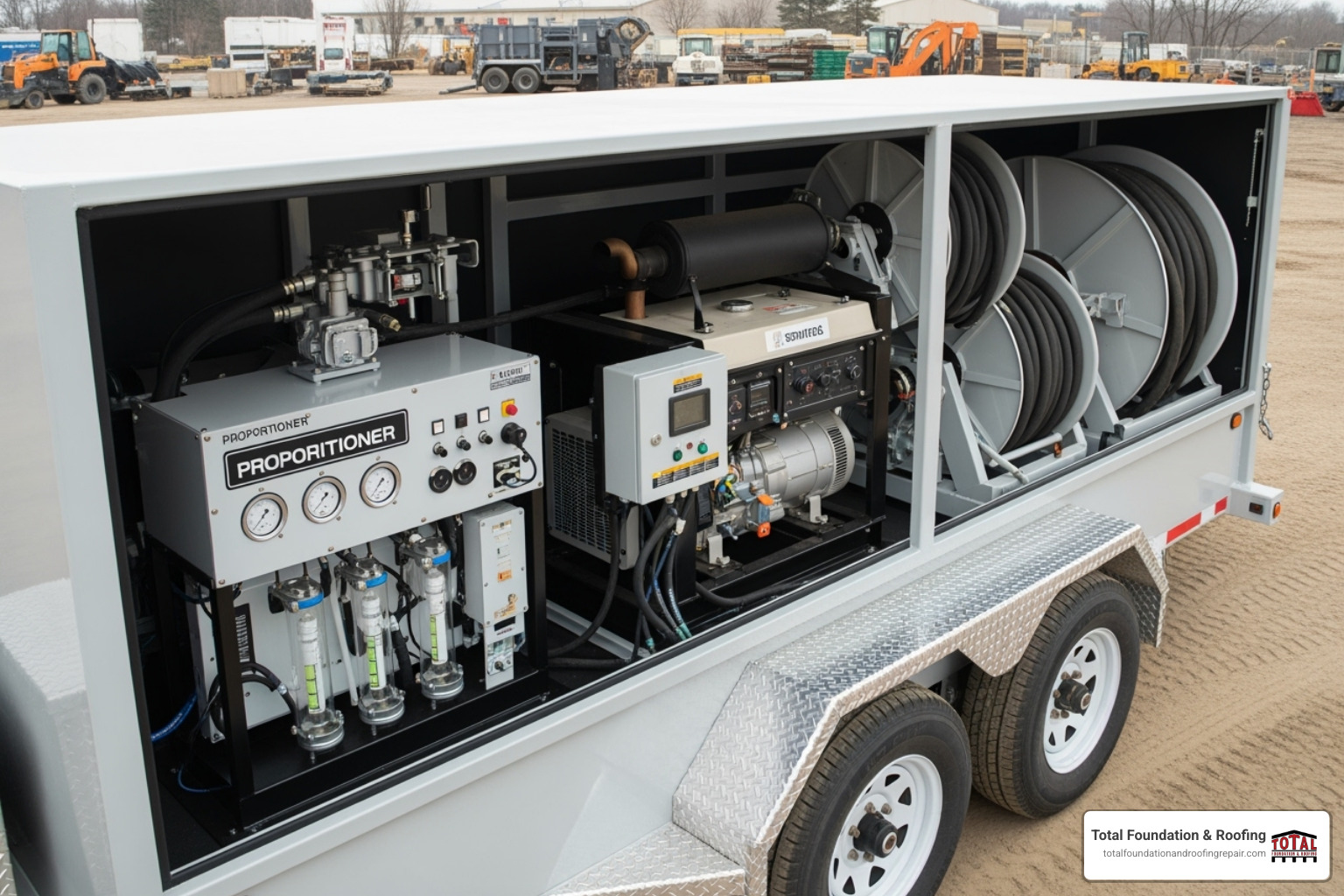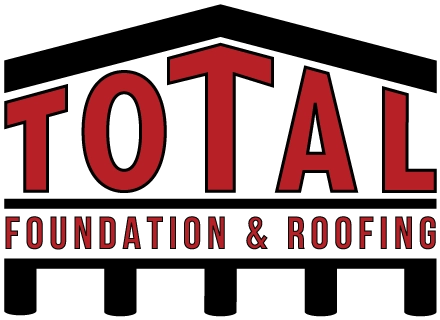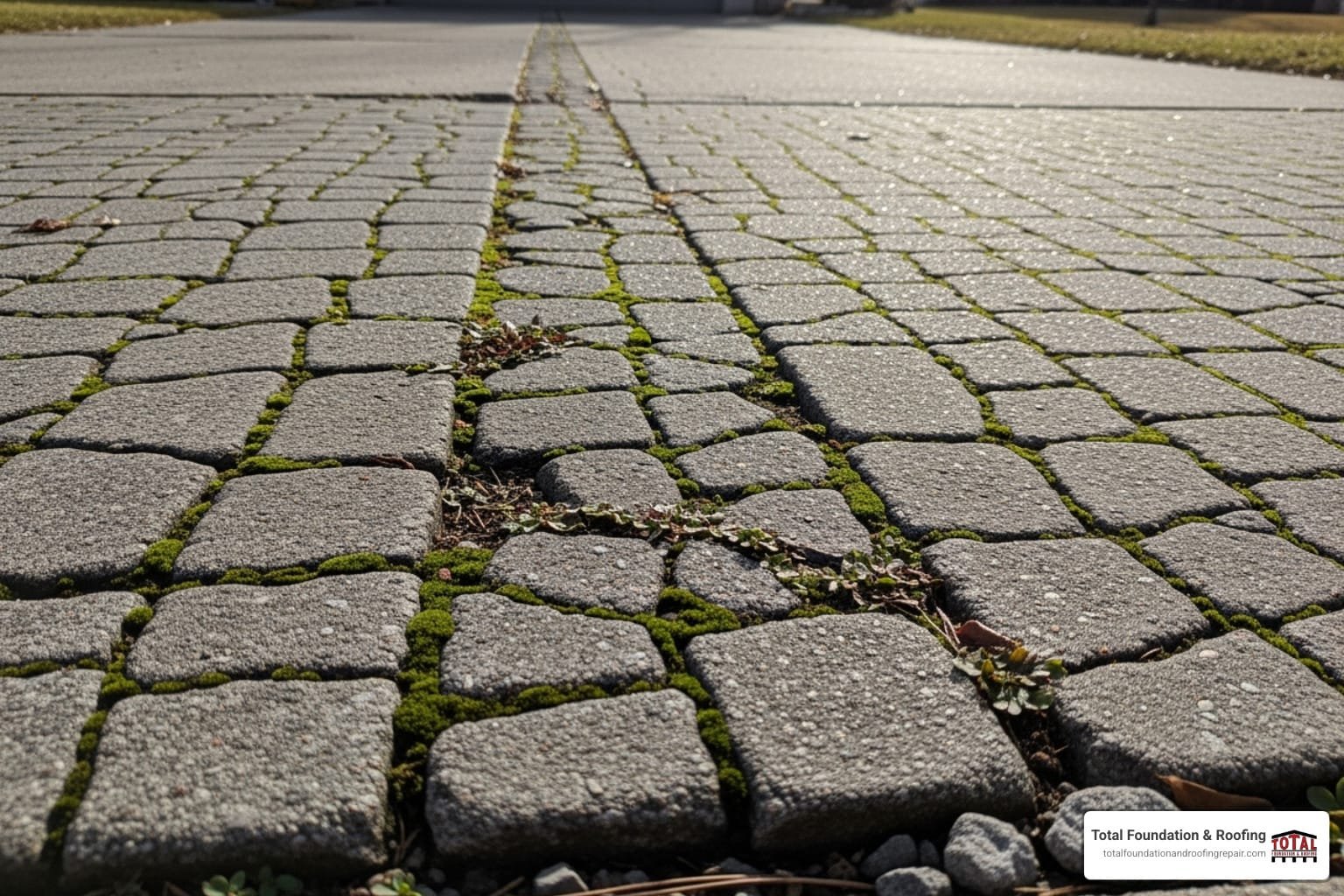Table of Contents
ToggleYour Guide to Concrete Lifting Solutions
Why Concrete Slabs Sink: The Root of the Problem
Ever walked across your driveway and noticed it’s not quite level anymore? You’re not alone. Understanding why concrete slabs sink is the first step toward choosing the right repair method and ensuring your concrete slab lifting equipment solution lasts for years to come. For expert guidance and proven results, turn to the trusted concrete repair professionals who keep Texas properties safe and level.
The most common culprit is poor soil compaction. When contractors don’t properly compact the ground before pouring concrete, the soil naturally settles over time. Think of it like building a house on loose sand – eventually, something’s got to give. This creates voids beneath your slab, and gravity does the rest.
Water erosion is another major troublemaker. A broken water line, clogged gutters, or even that heavy Texas thunderstorm can wash away the supporting soil under your concrete. I’ve seen perfectly good driveways develop serious settlement issues simply because a small plumbing leak went unnoticed for months.
Here in the Texas Hill Country, we deal with a particularly challenging issue: expansive clay soil. These soils are like sponges with an attitude – they shrink dramatically during dry spells and swell up when it rains. This constant push-and-pull creates stress on your concrete, leading to cracks and uneven surfaces. It’s why choosing the right foundation and concrete repair specialists is so important in our region.
Freeze-thaw cycles can also wreak havoc on concrete, though we’re fortunate to see less of this in Central Texas. However, when those rare hard freezes hit, any moisture in the soil expands, pushing concrete upward. When it thaws, the slab settles back down – often not quite where it started.
Don’t forget about vibrations from heavy traffic or nearby construction. Over time, these can compact the soil beneath your slab, causing it to settle. Even something as simple as slab curl – where the top of concrete cures faster than the bottom – can create instability that leads to future problems.
The Science Behind Sunken Concrete
Here’s the simple truth: a sunken slab is telling you the ground beneath it isn’t doing its job anymore. Whether soil settlement created the problem or water washed away the support, the result is the same – a void where solid ground should be.
Without proper support, your heavy concrete slab will crack and settle under its own weight. It’s basic physics, really. The hydrostatic pressure from water, combined with the natural settling of soil over time, creates voids that remove the slab’s foundation.
This is why professional concrete repair goes beyond just lifting the slab back into place. The best concrete slab lifting equipment doesn’t just raise your concrete – it provides soil stabilization to prevent future settlement.
When we tackle a concrete leveling project, we’re not just fixing the symptom; we’re addressing the root cause. This comprehensive approach to soil stabilization is what separates a quick fix from a lasting solution, ensuring your concrete foundation contractor work stands the test of time.
The Great Debate: Mudjacking vs. Polyurethane Foam Jacking
When it comes to lifting sunken concrete, property owners have two main options to choose from. For decades, mudjacking was the only game in town. But with modern advances in materials and equipment, polyurethane foam jacking has emerged as a game-changer. Understanding the differences between these two approaches will help you make the best choice for your specific situation.
Think of it this way: mudjacking is like using a sledgehammer to hang a picture frame, while foam jacking is like using a precision nail gun. Both can get the job done, but one is far more refined and efficient.
Here’s how these two methods stack up against each other:
| Metric | Mudjacking | Polyurethane Foam Jacking |
|---|---|---|
| Injection Hole Size | Large (1-5/8″ to 2″ diameter) | Small (5/8″ diameter) |
| Material Weight | Heavy (100-140 lbs/cu ft) | Lightweight (2-6 lbs/cu ft) |
| Cure Time | Hours to days | Minutes (often under 15 minutes for traffic) |
| Invasiveness | More invasive (larger equipment, more mess) | Minimally invasive (small holes, cleaner process) |
| Environmental Impact | Cement-based, can contain aggregates | Poly material composed of over 40% recycled material |
| Ideal Applications | Large, heavy slabs; budget-conscious | Residential, commercial, industrial; precise lifting; rapid return to service |
The Traditional Method: Mudjacking Equipment
Mudjacking is the grandfather of concrete lifting techniques. This method involves pumping a thick slurry mixture of cement, soil, and water beneath your sunken slab. The pressure from this mixture literally pushes the concrete back up to where it should be.
The concrete slab lifting equipment for mudjacking centers around a powerful hydraulic mudpump. This beast of a machine mixes and delivers the heavy slurry through thick hoses. Because we’re dealing with such a dense material, contractors need to drill large injection holes – typically between 1-5/8 inches and 2 inches in diameter – right through your concrete.
The cement-based grout flows like thick pancake batter, which explains why those holes need to be so large. While this method has lifted countless slabs over the years, it comes with some drawbacks. The heavy slurry adds significant weight to soil that’s already having stability issues. Plus, the process can be messy, and you’ll be waiting hours or even days before you can use your concrete again.
Interestingly, HMI invented the first hydraulic mudpump over 45 years ago, pioneering this approach that’s still used today. It’s proven technology, but like a trusty old pickup truck, it gets the job done without much finesse.
The Modern Solution: Polyurethane Foam Jacking Equipment
Polyurethane foam jacking represents the cutting edge of concrete lifting technology. Instead of heavy slurry, this method uses a two-component polymer system that creates expanding structural foam. It’s like comparing a smartphone to a rotary phone – both make calls, but one does it with far more precision and convenience.
The concrete slab lifting equipment for foam jacking is a marvel of engineering. At its heart sits a proportioner pump that precisely measures and mixes two separate liquid polymers. These components travel through heated hoses to keep them at the perfect temperature, then combine at the injection gun where the magic happens.
When these two components meet beneath your slab, they react and expand into a dense, structural foam that fills voids, stabilizes soil, and lifts concrete with remarkable precision. The best part? This entire process requires only tiny 5/8-inch holes that are barely noticeable once patched.
This clean, efficient approach is why more contractors are choosing foam over traditional mudjacking. Whether it’s driveways, sidewalks, garage floors, or even airport runways, polyurethane foam jacking delivers superior results with minimal disruption to your daily routine.
A Closer Look at Professional Concrete Slab Lifting Equipment

When I pull up to a job site with our concrete slab lifting equipment, homeowners often marvel at what looks like a high-tech laboratory on wheels. And honestly, that’s not far from the truth. A professional polyurethane foam jacking rig is essentially a mobile chemical processing plant designed for precision and efficiency.
These turnkey systems are typically mounted in a truck or specialized trailer, creating a completely self-contained operation. The beauty of this setup is that we can arrive at your property and begin work immediately, without needing external power sources or spending time setting up multiple pieces of equipment. Everything we need is right there, ready to go.
The heart of our mobile rig is the high-pressure proportioner, which acts like the brain of the entire operation. This sophisticated machine ensures perfect mixing and heating of the foam components every single time. Supporting this system is a robust generator that provides consistent electrical power, regardless of what’s available at your property. An air compressor handles the pneumatic controls and specific injection gun functions, while long, heated hoses maintain the foam’s optimal temperature as it travels from the proportioner to the injection point.
This professional setup allows us to work efficiently with minimal disruption to your daily routine. Whether we’re lifting your driveway, sidewalk, or commercial parking lot, our equipment is designed to get the job done quickly and cleanly, so you can get back to using your concrete surfaces as soon as possible.
Essential Components for Polyurethane Foam Jacking
The precision that makes polyurethane foam jacking so effective comes down to three critical pieces of concrete slab lifting equipment working in perfect harmony. Think of it like a carefully choreographed dance where each component plays a vital role in the final performance.
The proportioner pump is absolutely the star of the show. This sophisticated machine takes two separate chemical components (we call them the ‘A’ and ‘B’ sides) and mixes them at a perfect 1:1 ratio. Getting this ratio right is crucial because even a slight imbalance can affect how the foam expands, cures, and ultimately supports your concrete. It’s like baking a cake – the recipe has to be exact, or the results won’t be what you expect.
Connected to the proportioner are the heated hoses, which might seem like a simple component but are actually quite ingenious. These hoses maintain the material at an optimal temperature between 120-160°F as it travels from the proportioner to the injection point. This consistent temperature ensures the chemical reaction happens predictably, whether we’re working on a scorching Texas summer day or during a chilly winter morning. Without properly heated hoses, the foam might expand unevenly or cure inconsistently, which would compromise the quality of the lift.
Finally, there’s the injection gun – where the magic actually happens. This specialized tool combines the two heated components right at its tip, triggering the rapid expansion of the polyurethane foam. The gun must handle high pressure while allowing for precise, controlled injection, making it a critical piece of concrete slab lifting equipment. Some of our advanced guns even feature an auto calibrator that continuously monitors and adjusts the flow of each component, ensuring we maintain that perfect ratio throughout the entire job.
Key Features of Modern Injection Pumps and Guns
After years of working with different types of concrete slab lifting equipment, I’ve learned that the best injection pumps and guns share several important characteristics that make them reliable workhorses in the field. These features might seem technical, but they directly impact the quality and durability of your concrete repair.
The ability to handle significant back-pressure is absolutely essential. When foam expands rapidly beneath a concrete slab, it creates substantial pressure that can cause equipment failures or material blockages. Quality injection guns are engineered to handle this pressure smoothly, ensuring a continuous, uninterrupted injection process.
We’ve found that equipment with mechanical actuation tends to be far more reliable than systems dependent on complex electronic circuit boards. While electronics might seem more advanced, mechanical components like relays and circuit breakers are much more robust in demanding field conditions. They’re less likely to fail when exposed to dust, moisture, and temperature extremes, which means less downtime and more consistent results for our clients.
Easy cleanup might not sound exciting, but it’s crucial for maintaining equipment and keeping costs down. After each job, we need to thoroughly clean our equipment to prevent material buildup and prepare for the next project. Systems designed for quick, thorough cleaning save time and extend equipment life. Some advanced guns feature stainless steel components and simplified designs that eliminate problem areas like side seals or O-rings in the mixing block.
Portability has become increasingly important as we encounter more diverse job sites. While our main truck-mounted systems handle major projects beautifully, smaller portable units offer incredible flexibility for tight spaces or smaller jobs. These compact systems still deliver professional results but can access areas that larger equipment simply can’t reach.
For more detailed information about the machinery and technical specifications, you can visit a manufacturer’s resource like Polyurethane Machinery Corporation.
The Role of Mechanical Slab Jacks in Concrete Lifting
Sometimes, even with the most advanced foam injection systems, we encounter concrete slabs that need a little extra help. That’s where mechanical slab jacks come into play – another specialized piece of concrete slab lifting equipment that can make the difference between a good repair and a great one.
These heavy-duty jacks are particularly valuable when dealing with very large, stubborn, or exceptionally heavy concrete slabs. Think of situations where a massive driveway slab has settled significantly, or where a commercial walkway needs precise control during the lifting process. In these cases, we use mechanical jacks for pre-lifting – gently raising the slab a small amount before injecting any foam underneath.
This pre-lifting technique offers some significant advantages that benefit both the repair quality and your wallet. By creating an initial void and relieving some of the slab’s weight, we can achieve material reduction – using substantially less foam to complete the lift. This translates directly into cost savings for the project, as less material consumption means lower material costs.
Professional-grade slab jacks, like those rated for 12,000 pounds of static load, are designed to make lifting safer, faster, and more efficient. We’ve found these tools particularly helpful for complex jobs involving walkways and steps with landings, where precision and control are paramount. It’s another tool in our arsenal that demonstrates our commitment to choosing the right concrete slab lifting equipment for every unique challenge, ensuring we deliver the highest quality repair possible for your specific situation.
Beyond Lifting: Advanced Applications and Benefits

The versatility of high-density polyurethane foam extends far beyond simply lifting a settled concrete slab. This innovative material, combined with specialized concrete slab lifting equipment, allows for a range of advanced applications that address underlying soil issues and provide long-term stability.
One such application is deep soil injection, also known as deep soil stabilization or densification. Utilizing long injection lances, technicians can inject foam deep into the ground, sometimes up to 30 feet (10 meters). This process compacts loose soil, increases its load-bearing capacity, and fills deep voids, making it incredibly effective for stabilizing building foundations, warehouse floors, bridge abutments, and even highway approach slabs. This is essential for preventing future settlement by addressing the root cause of the instability.
Polyurethane foam is also excellent for void filling. Even if a slab isn’t significantly settled, large voids beneath it can lead to cracking and future problems. The expanding foam completely fills these cavities, providing uniform support. Furthermore, its ability to expand and densify soil makes it ideal for specialized tasks like seawall repair or stabilizing soil around pipe and tunnel segments. This process addresses the root cause of settlement, which is crucial for any lasting foundation repair.
Why Professional Equipment Matters for Your Property
Choosing a professional service that uses top-tier concrete slab lifting equipment offers significant benefits that directly impact the quality, longevity, and convenience of your concrete repair.
One of the most impressive advantages of polyurethane foam is its fast cure time. Unlike traditional methods that can require days for the material to fully harden, polyurethane foam cures in minutes. This means that a driveway or sidewalk can often be used for foot traffic within 15 minutes of injection, and for vehicle traffic shortly thereafter. This rapid return to service minimizes disruption to your daily life or business operations.
The material itself is also incredibly beneficial. Polyurethane foam is lightweight, typically weighing only 2-6 pounds per cubic foot. This is a stark contrast to mudjacking slurries, which can weigh 100-140 pounds per cubic foot. The lightweight nature of the foam means it doesn’t add significant stress to the underlying soil, reducing the risk of future settlement due to overburden.
Moreover, the foam is waterproof, which is a critical feature, especially in areas prone to moisture. It creates a solid, impermeable barrier that helps prevent future erosion beneath the slab, adding an extra layer of protection against the very water that often causes settlement in the first place. This modern approach provides a precise, clean, and long-lasting solution that protects your investment and restores the safety and appearance of your concrete surfaces.
Your Trusted Partner for Concrete Leveling in the Texas Hill Country
When you’re dealing with sunken concrete on your property, the choice between mudjacking and foam jacking really comes down to your specific situation. However, for most residential and commercial applications, the precision, speed, and minimal invasiveness of polyurethane foam lifting make it the clear winner. The advanced concrete slab lifting equipment used in this process ensures a durable repair that not only lifts the concrete but also stabilizes the ground beneath it – giving you a solution that’s built to last.
Here’s the thing: not all concrete repairs are created equal. You need a team that understands both the technology and the unique challenges of our region. The Texas Hill Country presents some pretty tough conditions, from our notorious expansive clay soils to sudden weather changes that can wreak havoc on concrete surfaces.
That’s where experience makes all the difference. When you work with Total Foundation & Roofing, you’re partnering with professionals who have spent years mastering the art and science of concrete lifting in our specific environment. Our experienced technicians use state-of-the-art concrete slab lifting equipment to deliver precise, reliable results that are custom-custom to our region’s unique soil conditions.
We’ve seen it all – from driveways that have settled due to drought conditions to sidewalks that have heaved during our wet seasons. Each situation requires a thoughtful approach, and that’s exactly what we bring to every job. Our team understands how expansive clay soils behave and we’re equipped with the right tools and techniques to provide solutions that stand the test of time.
Don’t let uneven concrete continue to be a safety hazard or an eyesore on your property. Whether it’s a tripping hazard on your walkway or a sunken driveway that’s affecting your home’s curb appeal, we’re here to help. Contact us today to schedule an assessment and restore both the safety and appearance of your concrete surfaces. We’ll work with you to find the right solution for your specific needs and budget.




